I enjoy tracing the White Mountains 100 course on a map. The lollipop loop is flung like a lasso over a small region of topographic ripples between the wide drainages of the Yukon and Tanana Rivers, which in turn divide expansive valleys between the Alaska and Brooks mountain ranges, which feather across a much larger landmass — all of it nearly uninterrupted by the roads, cities, and railroads that crowd most maps. The course itself is a tiny circle in this geographic expanse, nothing at all, and it's a hundred miles. It's a visual reminder of just how big Alaska really is — that one can walk 50 miles away from the nearest road, and still only be at the edge of a vast wilderness.
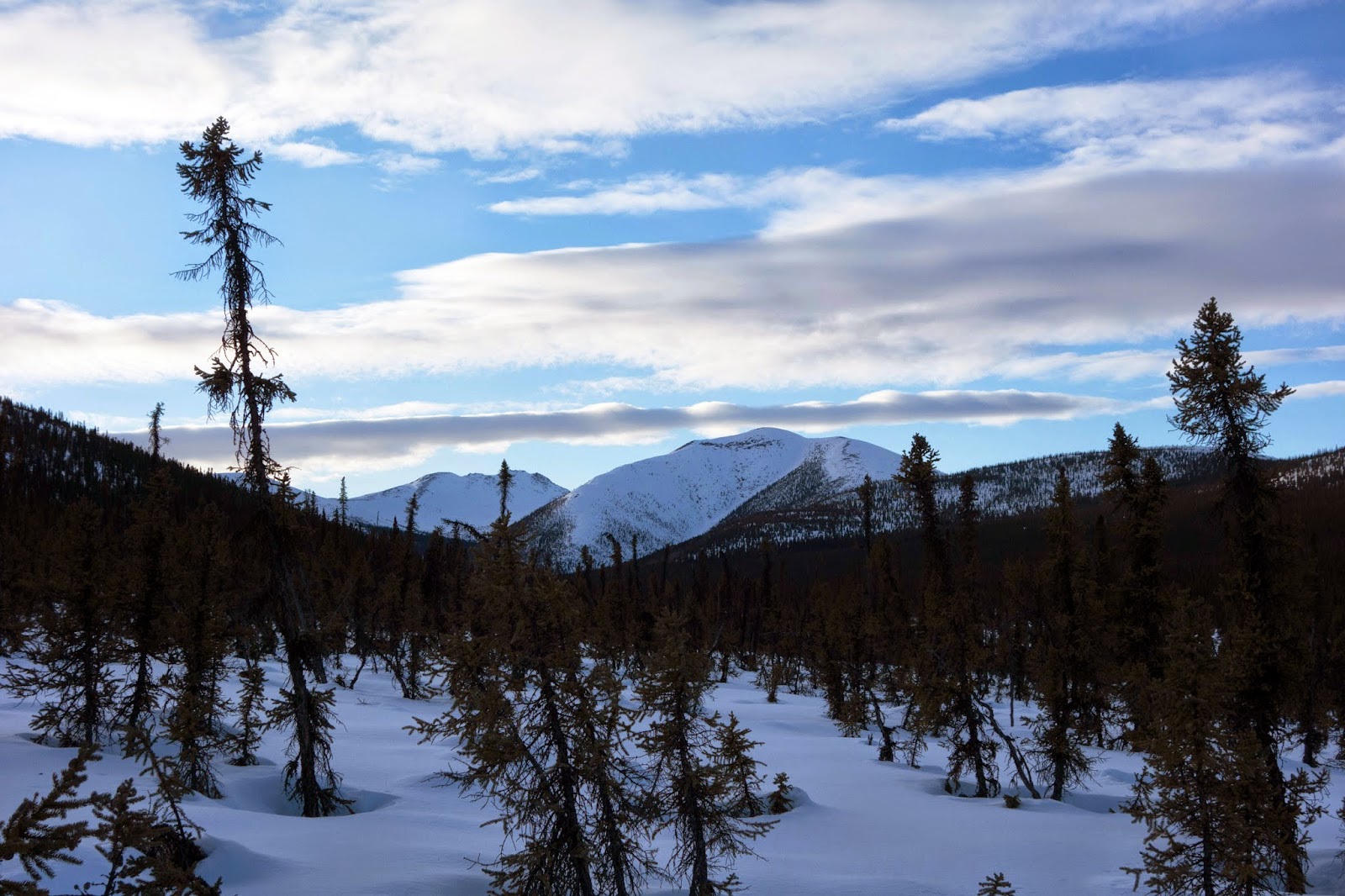
It may just be the edge of the wilderness, but the boreal forest felt wholly wild and remote as we began the climb to Cache Mountain Divide. Not many people travel here — even 40 miles is considered a good day's distance on a snowmachine, and fewer folks venture beyond the two cabins this trail connects. Trail conditions soon became notably worse. Before the cabin, I was punching through the crust every four or five steps; out here, most steps sank to my ankles at least, which is a long way to go when you effectively run on your toes. Determined not to give up the 4 mph average I'd so fiercely maintained, I pushed harder. This was a laughably losing battle. Trying to increase speed seemed to increase my weight/force ratio just enough that I only sank deeper. We again danced around the holes in the trail, searching for pockets of crust that would hold our weight. The edge of the trail seemed best but risky — too far over, and deep snow swallowed our legs to the knees.
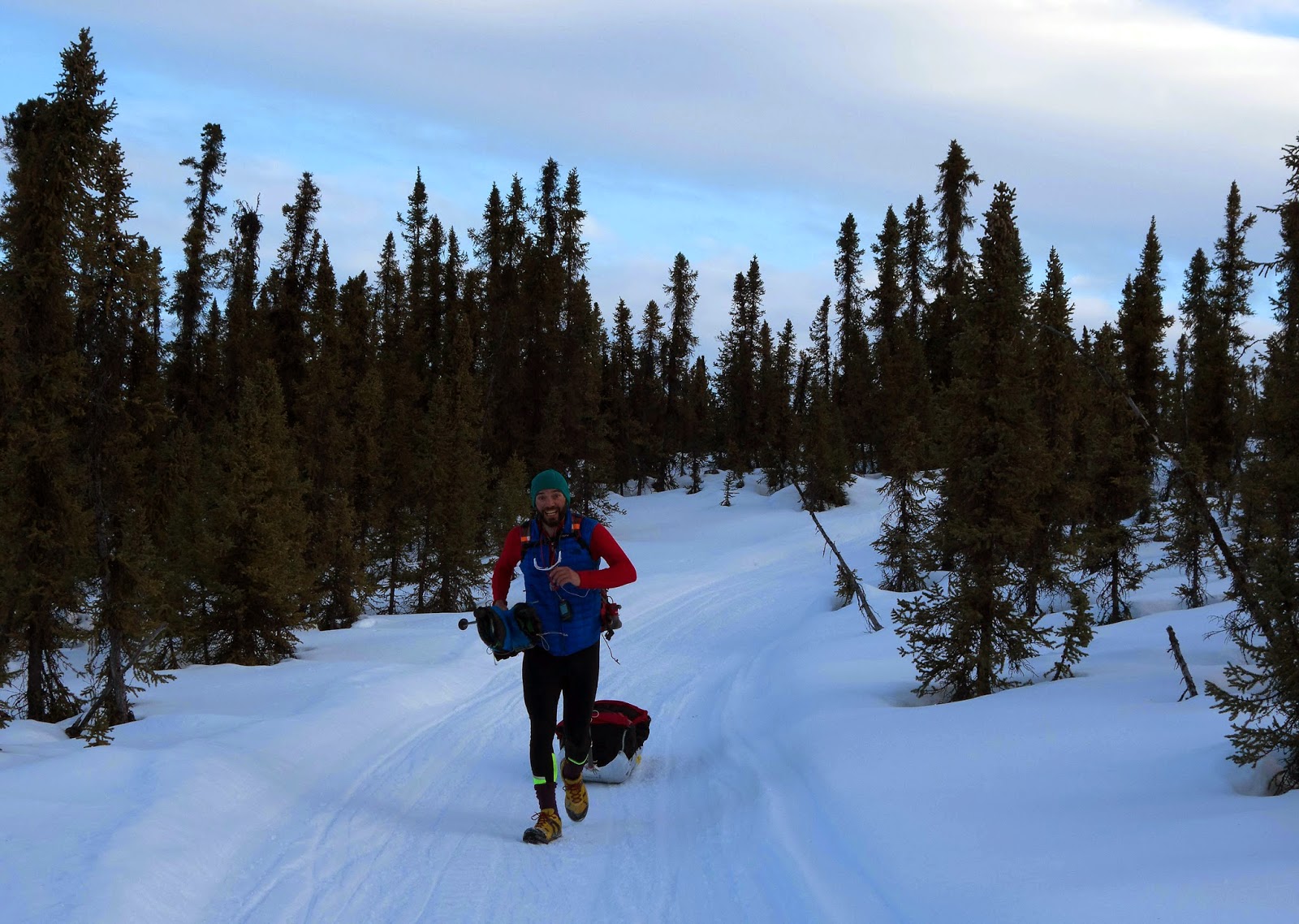
It was tedious work, but not unexpected — although we both became quiet for a while. I used silence to prevent myself from lapsing into defeated slog mode, and Beat likely kept quiet because he was in a fair amount of pain. Beat had all those hard miles on his legs, which were probably screaming not-so-subtly, "not this again." Eventually I decided I should break the tension by mocking some of the deep bicycle trenches left in the trail.
"I think they're all from the same biker," I said, analyzing the tire tracks with their well-rounded edge. "How could they not know it was time to let air out? If you're going to ride like that, why not just bring a road bike?" Still, whoever left these painful-looking tire tracks was still in front of us, so I was hardly in a position to criticize.
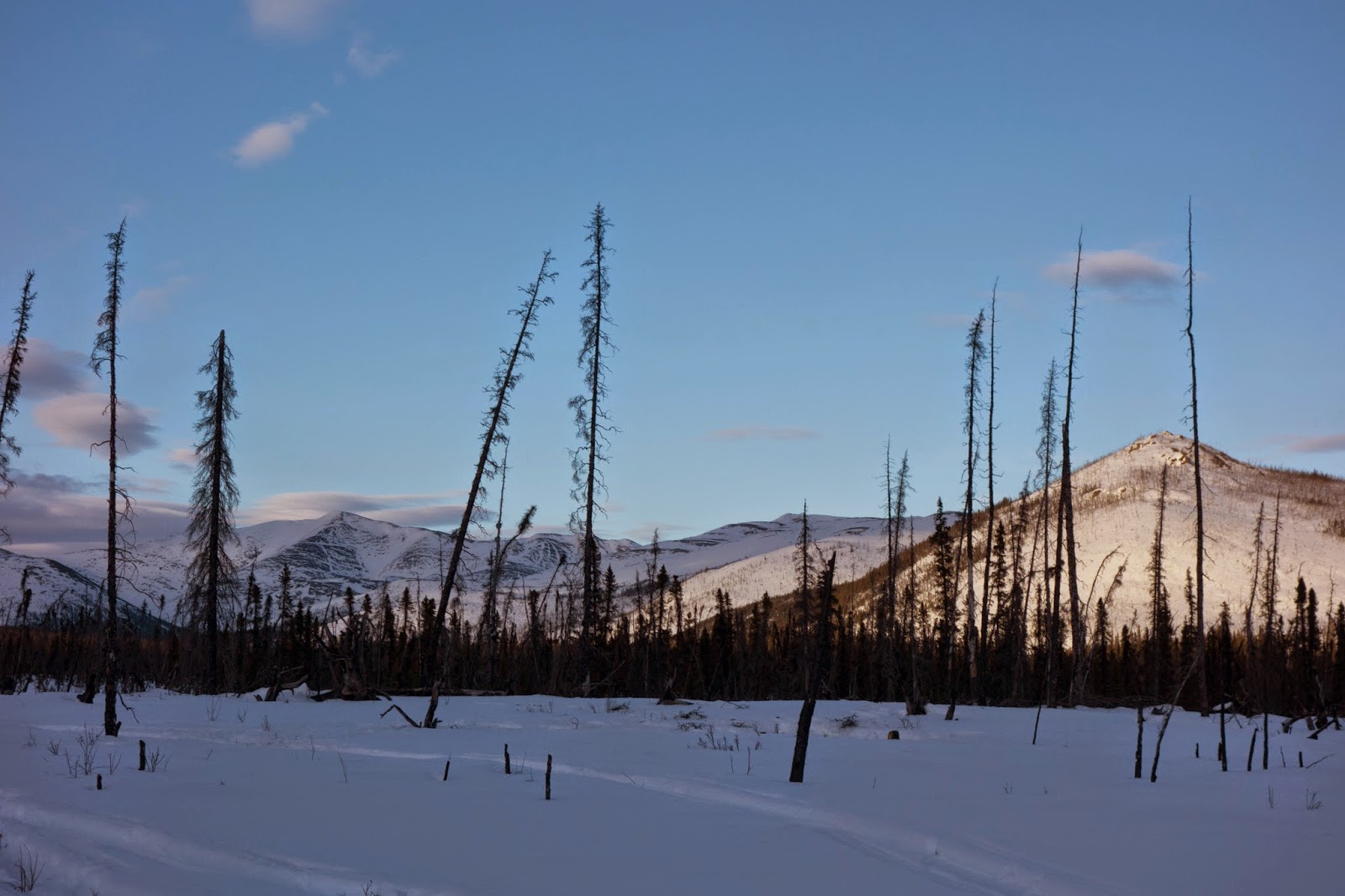
The steeper the trail became, the icier the surface, which was considerably better for walking. I could still float up the steepest grades, but the easier grades were a true slog, punched to Swiss cheese by all the bikers who also were reduced to walking. This is the main aspect of winter ultras that I always try to emphasize to newcomers — make note of the distances and elevation profiles, but then throw them out the window. Those statistics matter comparatively little next to trail conditions, which can't be predicted, and which can change by the hour (the faster bikers in the race likely made it over the pass before the slushy conditions set in, and also before other racers and volunteers on snowmachines churned up the "mashed potato" snow, leaving much softer conditions for those who came later.) Still, distance does matter. Regardless of what the trail is like, the mileage has to be covered.
The setting sun cast rich pink and gold hues on the surrounding peaks, framing this valley in a light I hadn't yet seen in four years of racing this course. "This time last year, I'd already rolled into the Wickersham Dome, devoured a brat and chili, spent an hour in the warming tent chatting with other bikers, and had driven halfway back to Fairbanks," I mused to Beat. I remembered rolling into the driveway before the sky was even fully dark, and walking rather breezily into the house for some leftover pizza and a full night of sleep. Then I smiled, because that was not where I wanted to be. This was where I wanted to be. This is what I came for.
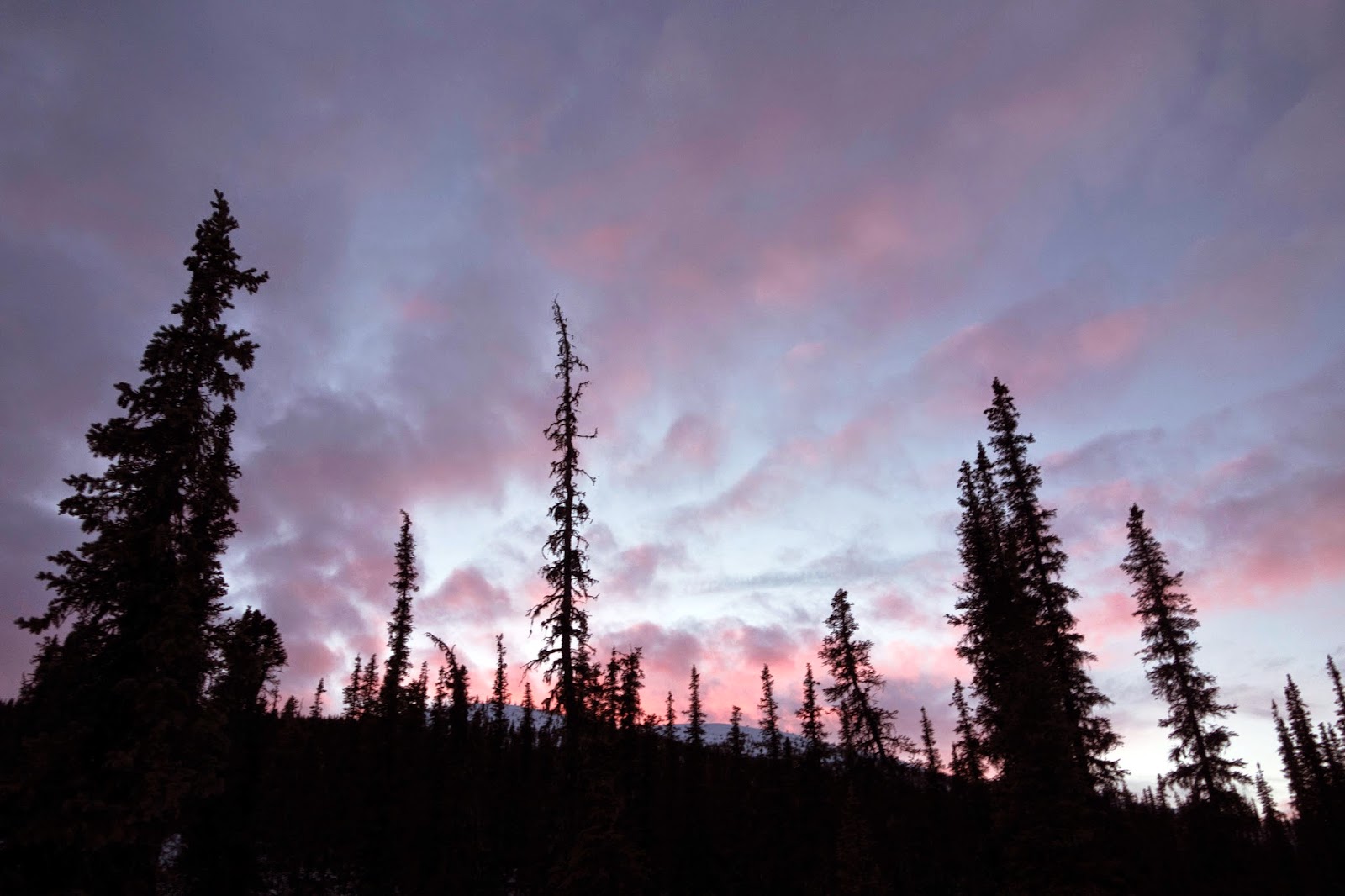
An iridescent half moon cast the mountains in bright silver and violet as we climbed above tree line. I've seen the Cache Mountain Divide in full sunlight and in cloud, but darkness gave it new depth — a stark contrast rendered by moonlight and shadows. As the sun retreated, warmth followed, and temperatures rapidly dropped at least 20 degrees. At the Divide, Beat and I embraced and shared a "summit kiss." We joked about taking it farther — an ongoing inside joke dating back to 2011 when a friend offered us ten dollars to make out during the Susitna 100. Then we laughed and laughed, because the windchill was already fierce, and because damn, were we sore.
I found it all so exhilarating that I took off like a runner down the pass, only to punch through the crust up to my shins, again and again, until I finally wrenched my right knee badly. Electric pain shot through my leg and I continued walking briskly, which is what I do when I'm panicked that I've hurt myself in a remote area, which is something I've been known too do. But the pain eventually diminished, and the joint was still bending okay. "No more running on the punchy snow. Don't let me run on the punchy snow," I said to Beat. But then ultra-amnesia took over, and exhilaration returned, and I returned to running. After turning my knee again and yelping in pain, I heard Beat yelling, "Don't run! You said you weren't going to run!"

We passed Cynthia, a runner from Nome who was having stomach issues and said she was considering scratching at a medical tent a few miles down from the pass. We encouraged her as much as we could, then continued descending toward the Ice Lakes — a narrow valley that collects runoff, causing a 1.5-mile-long section of overflow that can be anything from packed snow to glare ice to knee-deep water. This year, there was more snow on the Ice Lakes than I'd ever seen, and I thought we'd be granted an easy, anxiety-free crossing. When we reached the sections of glare ice, however, we encountered a paper-thin surface layer that had the terrifying tendency to shatter as we walked across it. Occasionally a fracture would compound across a ten-foot diameter of ice, which caused me to yelp, every time. Luckily the water underneath the ice layer was only a half inch deep or less, but occasionally I stepped in slushy puddles up to my ankles. There was one more advantage of brand-new shows: the waterproof outers were actually still waterproof.
In their need to urgently return from the Iditarod Trail, both Beat and Steve left their sleds in Koyukuk. For the White Mountains 100, Beat borrowed a sled from Dave Johnston, the current record holder of the 350-mile race to McGrath, who used this sled on another four-day blitz of the course this year. "Irma" the sled didn't have a runner, which didn't always agree with Beat's single-pole system. On steep descents or ice, the sled was all over the place, swinging ahead of Beat or dragging him sideways. Occasionally I heard Beat scolding Irma for misbehaving. We joked that she just wasn't used to moving so slowly.
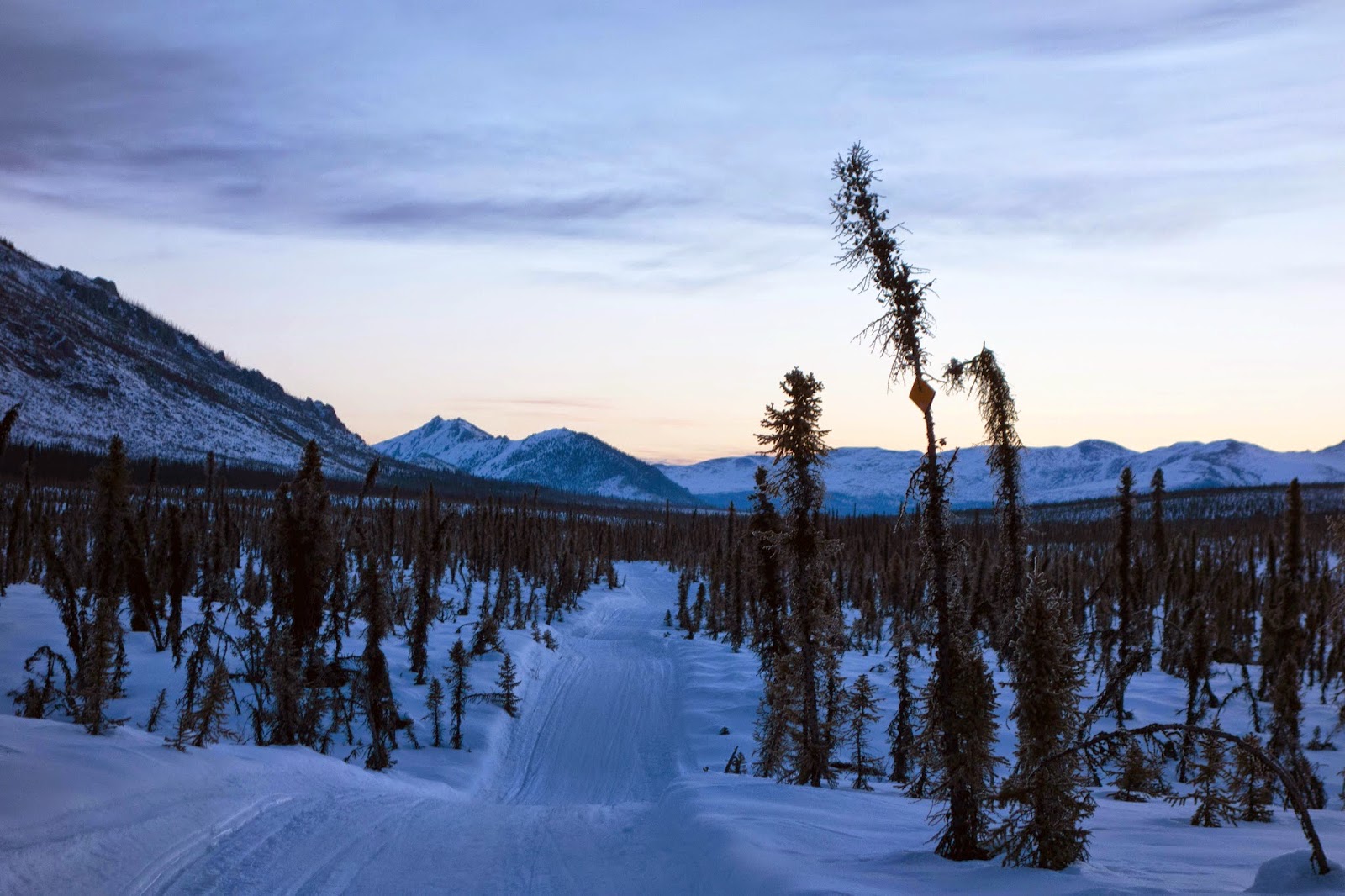
After Cache Mountain Divide, the trail descends through a narrow gorge formed by Fossil Creek, running beside sheer limestone cliffs. It's a stunning canyon, and the moonlight made it all the more surreal — like film noir, a cinematic rendering of something mysterious and slightly sinister. The Ice Lakes had been a cold sink, the breeze left us chilled, and the temperature continued to plummet. At my comfortable pace I could easily stay warm, but slowing down or stopping quickly left my fingers and toes tingling. I had a few more extra layers in my backpack — my puffy coat, mitten shells, and a balaclava. But since those were all I had, the prospect of putting them on made me nervous. Fully layered meant I had no buffer, and would be at the mercy of just how cold it could get here — which, based on recent experiences, was minus a lot.
I told Beat as much — that it was too cold for me to slow down. I think this annoyed him, because he could still see my puffy jacket tied to the outside of my pack. He again needed to make water and a meal, and I assured him we could take another long break at the cabin. But he said his fun meter had run quite low, and he'd be happier if he could take the rest of the course at a slower pace. He wanted to let me go ahead. More motivated by the creeping cold than anything else, I agreed.
We reached the Windy Gap cabin, mile 62, at 1:30 a.m. I was surprised to see at least five bicycles parked outside the cabin, among a few sleds. The small interior was crowded with racers, and stiflingly hot — which is usually how the indoors feel when one's body is in the process of adjusting to subzero temperatures. The meatball soup served here has historically been my favorite food of the whole race, but my electrolytes were off and this year it tasted strange to me, a bit like pencil shavings. The crowds made me feel antsy. I also felt guilty about Beat and all the chores he needed to complete when I was having difficulty concentrating on the smallest tasks.
When I have "ultra brain," which is a common thing to have a hundred kilometers into a hard run, I don't cope well around crowds. Aid stations can be a bewildering experience, and I try to form strategies to get myself in and out without interacting too much with other people. It's not that I don't appreciate volunteers (I do, very much), but their helpful gestures can quickly become confusing and overwhelming, and I start spiraling into an inertia trap. At Windy Gap, after eating the stomach-unsettling soup and collecting more water, I continued chatting with the bikers. I also tried to catch up with John, a volunteer who is a friend of mine, and absent-mindedly ate six or seven birthday cake-flavored Oreos. I swiftly regretted this. Sweat was pouring down my back, and I thought before I did too much more damage to myself, I should get out of there.
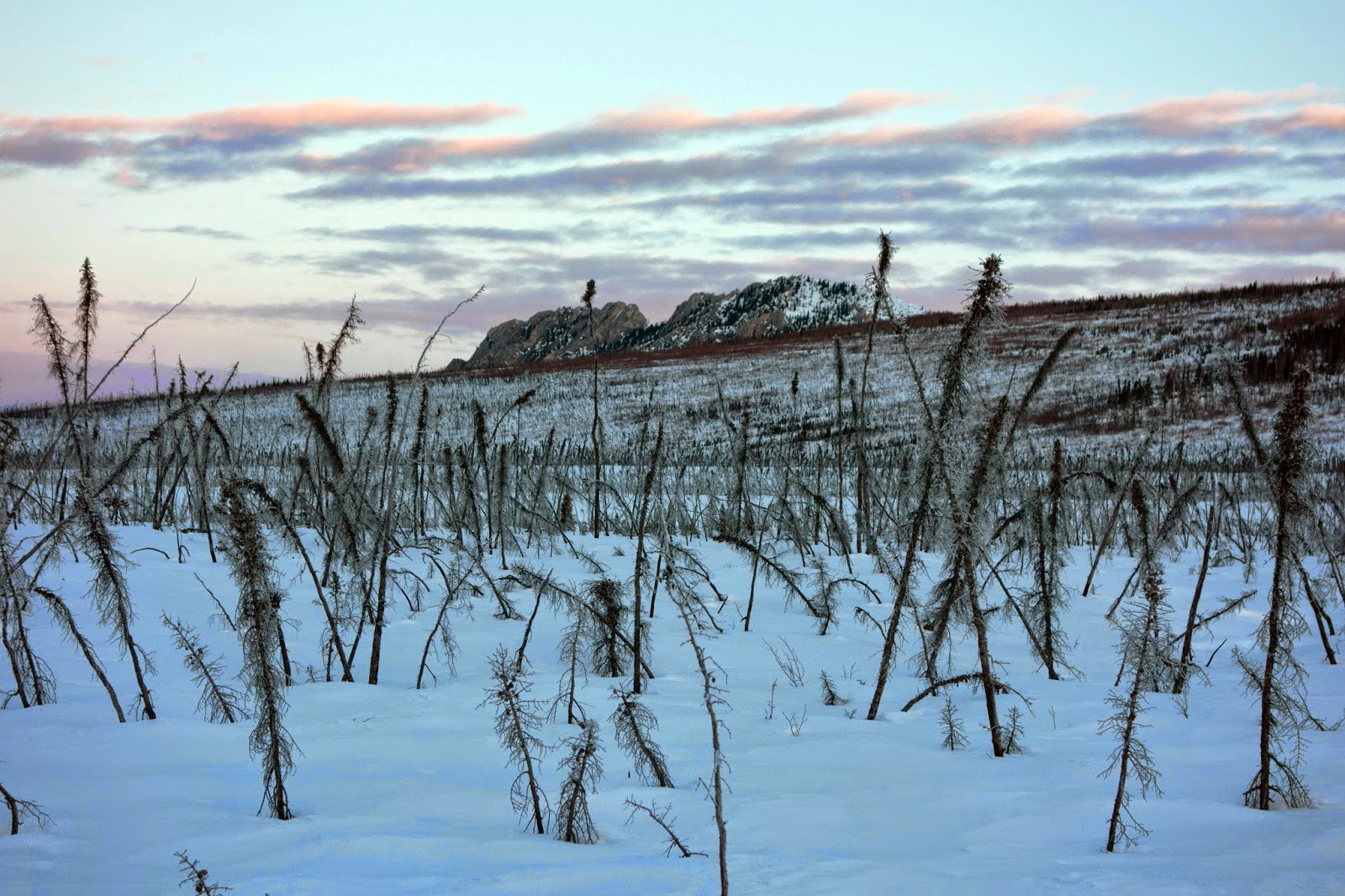
Outside, blades of green and white Aurora shot across the sky above the canyon, like a geyser of light erupting out of the limestone cliffs. In photographs and films, the Northern Lights are pretty, but in real life they're mesmerizing. For several minutes I stood next to the cabin, watching liquid light flow over the cliffs. Carole Holley had just arrived, and we stood in silence together until I starting shivering; I still wasn't dressed warmly enough to stand still. Beat was out on the porch melting water, and I gave him a kiss goodbye. I think he was slightly relived to see me go.
For the next few hours I hiked with purpose, forcing my throbbing legs into a jog when I became cold, and craning my neck to gaze through the corridor of spruce trees and moonlit cliffs to the sky overhead. Finally I put on my puffy coat, which improved my comfort level dramatically — funny, that — and relaxed. After Windy Gap cabin, the trail became better packed, but was consistently punched out with moose tracks — holes that are six to eight inches in diameter and often a foot deep. One misplaced step can easily break an ankle or leg. Just like rocks on a trail, they require constant vigilance to avoid, but I made the unwise decision to jog backward to give my quads a break and get a better look at the Technicolor sky to the north. Inevitably, I dropped my heel in a moose track and ended up on my back, putting an end to this silly practice. I continued jogging and dancing around moose tracks in an effort to reach Caribou Bluff — an open area with a wooden trail sign that I could use as a tripod to capture an image of the amazing light show for my memory files. Despite my best efforts, Caribou Bluff is still more than ten miles from Windy Gap. By the time I reached the valley, the Northern Lights were gone, and it was nearing dawn.

As daylight emerged, I climbed out of the Fossil Creek drainage and dropped into Beaver Creek, hopscotching with four of the struggling bikers. When I passed two on a shorter climb, one proposed I push his bike up the hill while he carried my trekking poles, reasoning that both were made out of carbon so the effort was a wash. I laughed.
"If you give me your bike, you know I'm going to keep riding it all the way to the finish," I replied. "Walking this whole thing isn't as easy as you think it is." I know, because I used to think exactly that about unladen runners with their little packs or sleds — they have it so easy. The grass is always greener.
I was generally feeling good, but mornings are always tough for me during these day-plus efforts. I'm naturally a night person and usually thrive during the dark hours, but I'm the opposite of most runners in that sunrise brings a psychological crash, not a boost. Red light appears on the horizon and my body says, "Oh wait, we did miss a night of sleep. Damn, I'm tired." Even as I could see the slope trending downward toward Beaver Creek, the trail felt steeply uphill. Batting frost from my eyelashes and sneaking fruit snacks through my iced-over face mask seemed to take all the energy I had left to give.
I reached Borealis cabin, mile 81, in full sunlight just before 8 a.m. It still felt frosty outside, and I was beginning to wonder if my internal thermometer was off kilter. Inside, the first thing the volunteers asked me was whether I was staying warm enough. "It's minus five here right now," one volunteer said. "Probably minus ten or more down on the creeks overnight."
"Huh," I said, shaking my head at the fifty-plus-degree temperature swing from the previous day. "I'm fine, just surprised it got that cold."
My energy levels were already perking up, and I decided to aim for the most efficient stop possible. I asked for a bowl of ramen and ate it as I reorganized my pack, filled up my water bladder, dried my hat and face mask, re-lubed my feet, and put on fresh liner and fleece socks that I'd been saving in case I stepped in overflow. With the heat of day coming and the threat of frostbite diminished, I felt justified in changing my socks, and couldn't contain little moans of ecstasy as I pulled them on my feet. Few sensations match the satisfaction of soft, dry socks on sore and pickled feet.
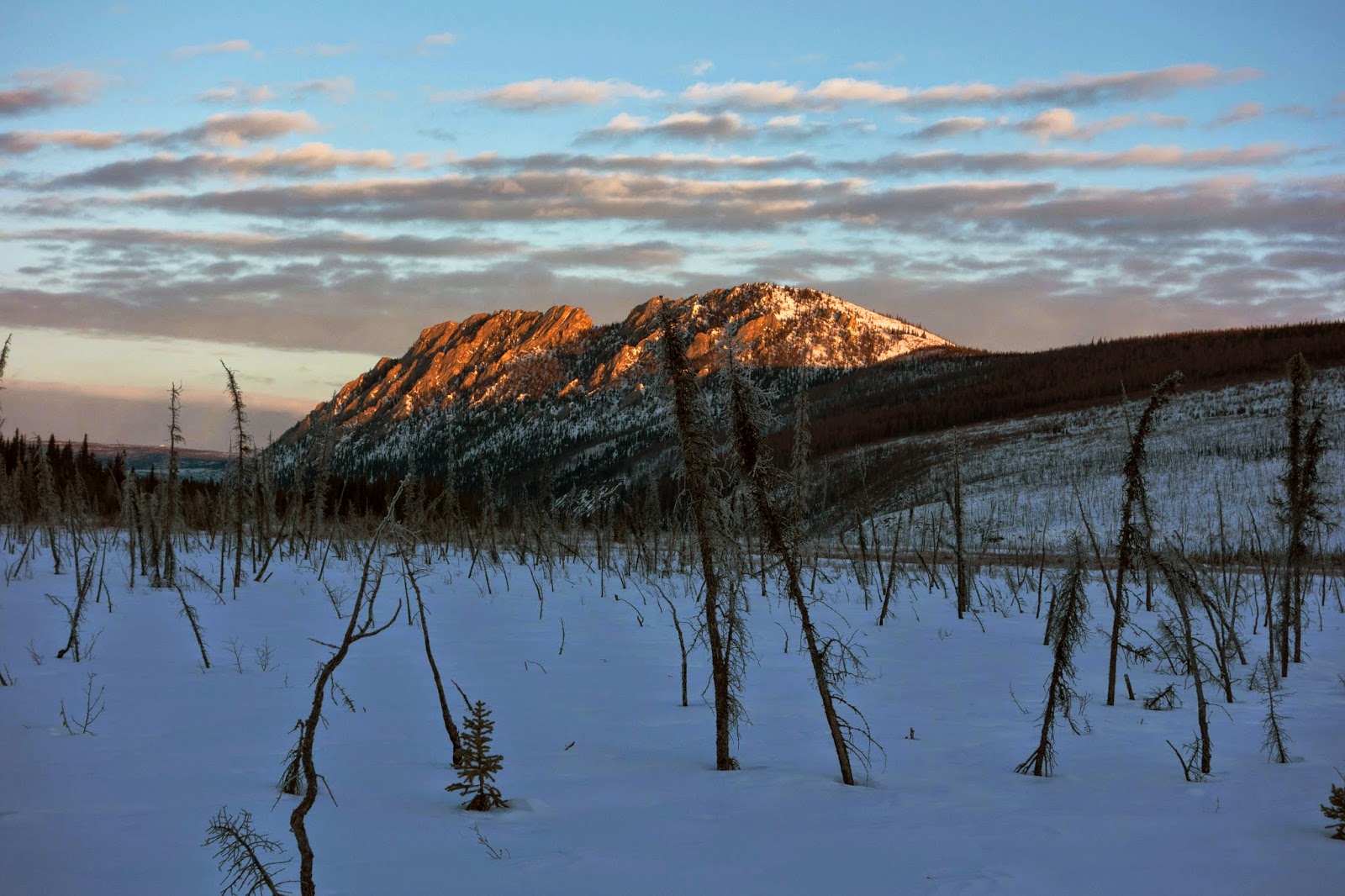
Leaving Borealis, I dropped onto Beaver Creek and continued about a quarter mile before I thought, "My face feels cold. Why is my face so cold?" When I realized I left my fuzzy blue neckwarmer at the cabin, I decided to go back for it — Beat sewed this for me earlier in the year, and it's become a favorite piece of gear. After leaving again at 8:30 a.m., I started doing math based on several past winter trips to this cabin. "Usually it takes six and a half hours to hike out of Borealis. That's on fresh legs, but with a sled and overnight gear. Six and a half hours would be 3 p.m. — 31 hours. I wonder if I ran the downhills, whether I could slice that time down to five and a half hours? A 30-hour finish would be rad."
Although my hundred-mile experience is still limited, I consider these winter hundred-milers at least as physically taxing if not more so than a mountain hundred-miler like the Bear 100. The variable snow surfaces and cold adds to the physical strain, and higher level of self-support and considerable remoteness doesn't allow runners to stumble along zombie-like — mental alertness is mandatory. From a race strategy standpoint, I'd managed the White Mountains 100 about as well as I possibly could up to that mile. A strong finish to a sub-30-hour PR would be a sweet reward.
Just as soon as I thought this, everything started to hurt. My hamstrings burned, my quads were weak, and the bottoms of my feet felt like someone was slapping them with a board full of nails. My shoulders, forearms and hands were still wrecked from Shaktoolik; I felt shooting pains from shouldering my pack, and found it difficult to maintain a grip on my trekking poles, dropping them frequently.
As the sun climbed higher in the sky, the air temperature made another dramatic swing toward something unbearably warm. Many runners who have exceeded 24 hours in an effort will likely understand the concept of "second-day heat." The afterburners are running on high, muscles are excreting an enormous amount of heat, and core temperature becomes more difficult to regulate. Even before the temperature climbed above freezing, I was stripping off layers and quickly as I'd applied them during the frigid night. Down to my base layer and still overheating, I started to daydream about taking off my shirt and pants, and running in only a bra and underwear. "I'd probably run faster, like a sled dog," I mused. "I wonder if anyone would care?"
 |
| Photo by Corrine Leistikow |
I stopped at the trail shelter, mile 90, desperate for salty snacks and Gatorade. I told the volunteers about my goal of breaking 30 hours, and they just nodded politely, no doubt wondering what my deal was when they'd watched the fast bikers go through a day earlier. A half mile later I ran into Tony Covarrubias, who was out for a "short" 20-mile training run while waiting for his wife to finish the race. He jogged with me for a couple of miles, and I apologized whenever I slowed to a walk. "I always fall apart at the end of these 100-milers," I said. "I do want to break 30 hours, and I can technically run. But I still don't have this ultrarunner thing down. I don't like when my legs hurt and I don't like when my feet hurt. I don't believe Beat when he tells me it will go numb."
Tony, who has finished 500-mile events, agreed. "It never goes numb."
Tony left me behind on the climb up the Wickersham Wall, a steep 800-foot gain that comes rather brutally and abruptly at mile 93. This year, the climb was a relief for me because it meant I didn't have to force my legs into running strides. Halfway up the Wall, I met my friend Corrine, who had ridden out the trail on her snow bike to cheer.
 |
| Photo by Corrine Leistikow |
This photo illustrates well the final six miles of the White Mountains 100. I wasn't posing at all; I was deep in the pain cave, walking with this stance when I wasn't forcing a lumbering, tender-footed jog. Corrine again caught up to me at the top of the Wickersham Wall and proclaimed, "six more miles!" I looked at my GPS and groaned. "It's 12:27, just 90 minutes, it can't be done." Four miles an hour doesn't sound so difficult, but that was my average pace at the beginning of the race. The six miles to the finish along the rolling ridgeline included many steep climbs, and making up for walking uphill was going to require *at least* a 5 mph downhill pace, which hurt so much. Math was killing me.
"It can't be done," I whined to Corrine, only to watch her ride a half mile ahead, wait for me to pass, and continue cheering me on — "Five more miles! I think you got it!"
I passed another spectating friend on a bike, Jay Cable, who commented that he was surprised to see me running hard down the hill. "I think Dmitry is about 20 minutes ahead," he said.
"I'm not trying to catch Dmitry, I'm trying to break 30 hours," I gasped, and then silently kicked myself, because why do I keep telling people about this 30-hour thing?"
I was two miles from the finish at 1:32 p.m., with still over a mile to climb on the final hill. Corrine was still stopping every half mile to cheer me on, and I no longer had the energy to respond with defeated phrases, instead just breathing out a long "Ugggh." She waited one last time at the one-mile-to-go sign, where I stopped briefly for one last GPS check. 1:44 p.m. "I guess I gotta go for it."
 |
| Photo by Corrine Leistikow |
So I picked up my hurty feet and numb legs and ran fast, as fast as I could, until I could feel the wind in my face, finally whisking the fire away from my overheated skin. It felt like flying — extremely painful flying. I felt as though I'd never run faster, although GPS stats betray the reality of a 10:18-minute-mile. It was enough. I arrived at the parking lot at 1:54 p.m. Official finish of the 2015 White Mountains 100: 29 hours and 54 minutes.
The first thing I did was soak my bare feet in the snow, until they went numb, and then I crawled onto a cot inside the race trailer. I hoped to catch some shut-eye before Beat arrived, but my legs continued to feel like someone was slapping them with board full of nails. "This is the worst pain ever," I winced. "I'm not going to be able to sleep for a week." Then I lapsed into unconsciousness anyway.
Beat arrived sooner than I expected, an hour and a half later, having achieved his own, unofficial, self-supported finish on the course in 31 and a half hours. Poor Beat was in a lot of pain, and said he regretted this from mile five onward. When asked why he didn't turn around, Beat first blamed me, my bad ideas, and my unrelenting forward motion. Then he shrugged. "Pride."
After what Beat accomplished on the Iditarod Trail, battling deep snow, unbroken trail, and temperatures down to 46 below for ten days to reach the Yukon River, the White Mountains 100 was comparatively a short and pleasant stroll. He didn't have anything to prove by completing the course again — there wasn't even a jacket in it for him. But he did it anyway, which speaks to his dedication (and stubbornness.)
I'm stoked about how my race went, and of course already thinking about all the ways it could have gone even better if I'd properly trained and didn't wear myself down on my coast bike tour (which was considerably more strenuous than running the White Mountains 100.) But really, any trip into the White Mountains is a wonderful privilege. I remain in awe of the experiences I've had here. Every return is like visiting an old friend — someone I only see sporadically, but when we're together everything looks and feels as though no time has passed, and we've never been apart. I may live 3,000 miles away, but I can hardly imagine my life without the White Mountains, the stunning skies of these northern latitudes, and the wonderful people in Fairbanks who really make all the difference.
I'll be back again, undoubtedly.



































